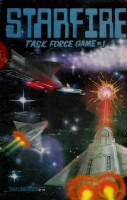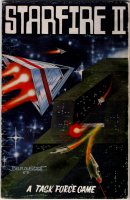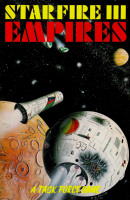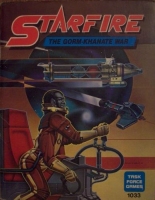STARFIRE started as a pocket box game created by Steve Cole in 1976 and first published by Task Force Games in 1979. STARFIRE was designed as a fast-paced game of fleet-level starship combat with an easy-to-use starship design system and simple system for technological progression. In 1980 Task Force Games worked with David Weber to create and release a supplemental expansion that added strategic rules, "empire building", and galactic conquest to the STARFIRE system.
STARFIRE has a uniquely simple system for building and handling starships: each starship is represented by a row of letters, with each letter representing a weapon, defense, or other system. STARFIRE adds interstellar travel between the stars through natural "wormholes" (called "Warp Points") that exist in most star systems. In fact, no "strictly" Faster-Than-Light (FTL) propulsion technologies exist in any edition of the STARFIRE system.
STARFIRE includes not only tactical and strategic levels of play, but there is an operational layer at the scale of a star system. Using the operational scale, starships move around the star system to detect enemy ships and bases and then attempt to maneuver and engage in combat to their advantage. This added "Fog Of War" makes the operational layer maneuver hugely important to how tactical battles play out – and often who wins.
STARFIRE NOVELS by David Weber and Steve White
STARFIRE NOVELS by Steve White, Shirley Meier, and Charles Gannon
In 2007 Steve White and Shirley Meier continued the STARFIRE novels in the
CLASSIC STARFIRE history with
Exodus, the story of the Arduan empire's exodus from their home star-gone-nova, arriving at the doorstep of the Pan-Sentient Union expecting to colonize worlds they discovered are already occupied by the Terran Federation. In 2011 Steve White and Charles Gannon contined the series with
Extremis,
Imperative, and
Oblivion, which continue the Arduan story arc with additional exodus fleets arriving in Pan-Sentient Union space with a different agenda.
David Weber is a long-time author of military, science fiction, fantasy, and alternative history books...with his name on more than 80 books. He is best known for his Honor Harrington series, the Safehold series, and the original Starfire series of novels. You can read more about David Weber on his website at
www.davidweber.net. Be sure to check out the library of books he has on his site!
Steve White is a long-time author of STARFIRE novels, having co-written the original Starfire series of novels with David Weber. He has an extensive list of works including The Disinherited, Debt of Ages, and Prince of the Sunset.
Dr. Charles Gannon is the newest author to the
STARFIRE universe, but has an extensive writing background and has written for
Traveler,
2300 AD, and other gaming systems. A professor of American Literature at
St. Bonaventure University, he has also written several academic publications. You can find out more about Dr. Gannon at his website,
www.charlesegannon.com, and about his involvement in the
STARFIRE universe at his
Starfire World Page. More recently Dr. Gannon has written numerous books in his own
Tales of the Terran Republic series, where Earth finds itself in first contact with a Concordium of advanced alien species all closer to Earth than expected.
First Edition ORIGINAL STARFIRE
The First Edition of STARFIRE was first published as a pocket game by Task Force Games in 1976. Consisting only of tactical starship combat rules, it also included that introduced the Terran Federation, Khanate of Orion, and Ophiuchi races of the original STARFIRE history.
Two supplements were released for First Edition: STARFIRE II Strikefighter and STARFIRE III Empires (which introduced the first empire-building strategic rules to the STARFIRE system).
Second Edition ORIGINAL STARFIRE
In 1984 Task Force Games released the 2nd edition of STARFIRE, republished as a box set and combining the Starfire I and Starfire II rules as a single book written by Dave Crump and David Weber. The New Empires supplement was an vastly improved and expanded set of strategic rules for campaign games. For the first time, fleets maneuvered across entire star systems. Gorm-Khanate War added a new race, the Empire of Gormus, and the short war between the two empires where the Gorm so impressed the Orions that they were offered a partnership after losing the war.
Changes in Second Edition included dropping half points of damage, adding variable hull sizes for ship construction, improved fighter balance, crew grade, and the concept of drive rooms.
It was also during this time that the Nexus Magazine was published (through 1986) with 18 issues. Nexus included many articles on the STARFIRE system. After it was discontinued there was no new STARFIRE material released until the next edition.
The original STARFIRE miniatures produced by TFG were released during the Second Edition. The miniatures were a smaller size intended for use on a regular hex-grid map. Most of the ship types in the game were represented. However, there were no empire-specific ship designs in the line and only painting determined the difference between races.
Third Edition CLASSIC STARFIRE
Now known as CLASSIC STARFIRE, in 1992 Task Force Games released the Third Edition Tactical Rules in a box set, designed by David Weber. Large parts of the rules were rewritten and expanded. The most notable change being that new rules used a d10 system rather than the older 2d6 system. The rules were redesigned to integrate the strategic rules directly with the tactical system. In 1993 the campaign system Imperial Starfire was released. Over the next few years nearly all of the Third Edition products were released: First Contact (1993), Stars At War (1993), Crusade (1993), Alkeda Dawn (1994), and Sky Marshal #1 (1995).
In 1997 Task Force Games worked with the Starfire Design Studio (SDS) to produce several electronically published STARFIRE products. This allowed the publication of the long-delayed Sky Marshal #2 (1997) and The Fourth Interstellar War (1997).
Classic Starfire and the Starfire Design Studio
In November of 1997 Task Force Games sold the STARFIRE gaming system to Marvin Lamb (the Starfire Design Studio). The Electronic Communique (EC) started in 1997 and continued until 2000 with more than 40 issues. Andy Blazel updated and modified Marvin's own ship designer program so it could be released as Shipyard. In 1998 the SDS released the Third Edition Tactical Rules, Revised and Insurrection, a supplement based on David Weber's novel of the same name that detailed the Terran Civil War.
In 2002 the SDS and 3rdR Design Group released an additional product called the Unified Tech Manual. It combined all the technologies from all the Third Edition supplements and added a few new technologies. This was the last Third Edition product for CLASSIC STARFIRE.
In 2015 the SDS re-released the CLASSIC STARFIRE products in electronic format. That necessitated creating new covers for the handful of products that did not have cover art. Those products were Sky Marshal #2, The Fourth Interstellar War, and Insurrection.
Classic Starfire and Non-Weber Supplements
Between 1995 and 1997 there were two additional supplements published by Task Force Games that were not officially part of David Weber's Starfire history. These were First Contact and Alkeda Dawn.


Alkeda Dawn is a completly new history created by Mark Costello and Bryant Wu. It detailed the flight of the Vestrii from the Hre'Daak, an ancient empire that believed everyone must join them or be eliminated. The Vestrii fled across the stars for centuries, meeting a race of religious fanatics (the Kess), and a race of cyborg fleets that wander the galaxy harvesting organic and inorgranic resources from whomever they meet (the J'Rill).
First Contact was to be a bridge between the Alkeda Dawn history and the Weber/White history, briefly detailing when the Vestrii found the Grand Alliance and fought briefly against the Tangri raiders. It is generally regarded as a novelty item and not officially part of the CLASSIC STARFIRE history.
4th Edition GALACTIC STARFIRE

Galactic Starfire was launched by the SDS to shift the focus from scenario-driven combat to the strategic game, since the player-base were more interested in campaign games. The focus on balancing the technologies with each other, and on more balanced strategic gameplay, was paired with a drive to increase the simplicity of the game and allowing the player to focus on the decisions that mattered. Nearly every rules section, technology, and game concept was re-evaluated over several years and culminated in two playtest campaigns. By the end of 1999, Marvin hired Matthew to help coordinate the volunteer work and do pre-publication editing. In April 2000, Galactic Stafire was prepped for release in time for Origins and GenCon that summer.
In 2002 the Starfire Design Studio released the Elite Starfire supplement to Galactic Starfire, adding new optional and alternate rules along with completely reworked rules for squadrons and automated platforms.
In May 2000 the SDS released Admiral's Challenge for 4th edition. This supplement was a set of alternate rules for strategic gameplay on a hex map. Each hex became a system and fleets would move, detect other fleets, and react over interstellar distances on an open map. Admiral's Challenge brought the strategic map back to the tabletop while still using the remaining core tactical and strategic rules from Galactic Starfire.
5th Edition ULTRA STARFIRE
In November 2004 the SDS released Ultra Starfire. Updated over the next 5 years, the goal of Ultra Starfire was to produce a set of rules that were streamlined, with reduced paperwork, and that the gameplay and technologies were fully balanced for player-versus-player games. Designed without a background history, the Ultra Starfire rules were designed for the player who wants to play competitive games with the strategic rules.
Ultra Starfire was the first ruleset with all of the rulebooks and documents were fully integrated into a cross-linked set of electronic documents, released in PDF format. Because it was an electronic document, the occasional errata, updates, and other corrections were made available as downloads to the players who purchased Ultra Starfire.
Corbynova Starfire Online
In 2004 the Starfire Design Studio worked out a deal with CorbyNova to make the CorbyNova website the official computer support for
Ultra Starfire. Corbynova created an online browser-based assistant program to help players with their games and run campaign turns.
http://game.starfireonline.com/index.html. Unfortunately,
Starfire Online is no longer available.
6th Edition SOLAR STARFIRE
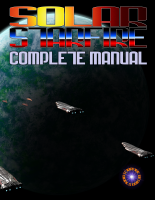
On February 1st, 2012, the SDS released the current edition of STARFIRE. Based on the Ultra Starfire ruleset, the Solar Starfire rules have been designed for story-based campaign play. The rules are being designed to tell the story of a new background history — the History of the Terran Solar Union. This means new concepts, new technologies, and new rules!
With such a vast number of changes to the rules, changes to the technology, and plans for continued updates and revisions based on the events in the history, SOLAR STARFIRE is planned to be under continuous development and expansion.
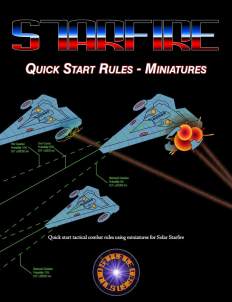

The Quick Start Rules is a free downloadable introduction to the tactical rules for Solar Starfire designed to teach new and returning players the tactical rules and concepts in several steps. It includes scenarios and printable counters and hexgrid that can be glued to cardboard so that anyone can try out the game.
The Quick Start Rules for Miniatures is another free, but experimental version of the Quick Start Rules that has been tailored for playing with miniatures on an open tabletop. Using inches instead of tactical hexes, it includes the same rules and scenarios but changed to use inches and angles instead of hexes and hexsides. Also included is a cutout for the turnkey used to turn the miniatures the correct number of degrees.








